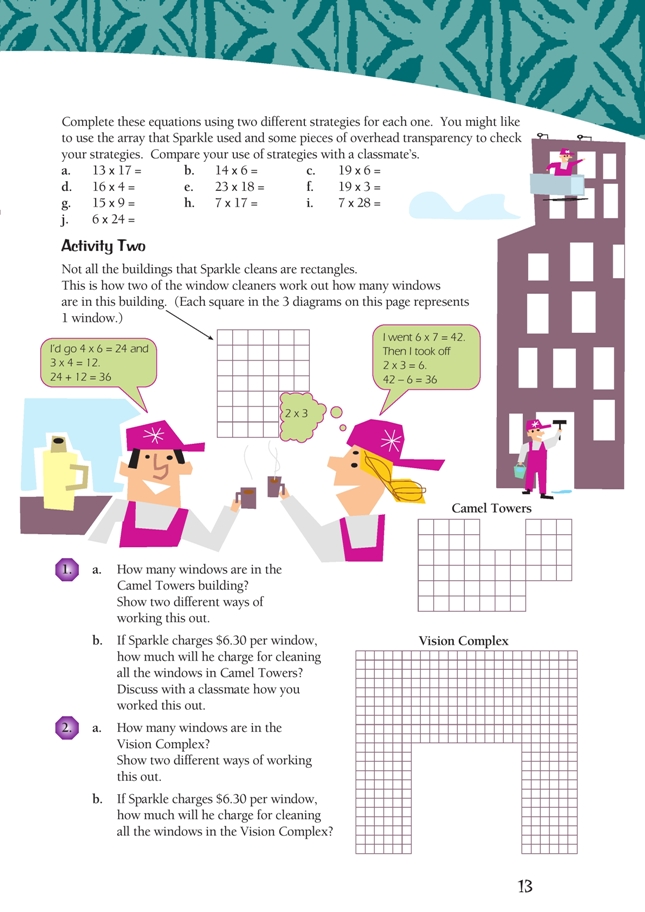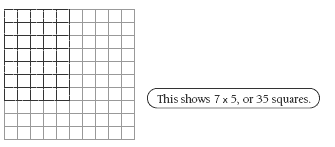This is a level 4 number activity from the Figure It Out series. It relates to Stage 7 of the Number Framework.
A PDF of the student activity is included.
Click on the image to enlarge it. Click again to close. Download PDF (172 KB)
solve problems using multiplication arrays
2 pieces of coloured overhead transparency (optional)
A calculator (optional)
FIO, Level 3, Number, Book 3, What a View! pages 12-13
Activities One and Two
These activities are similar to those on pages 6–7 of the students’ book in that they present a variety of strategies for students to experiment with and use, including multiplication strategies and the use of arrays.
Arrays are used to help develop the students’ understanding of what they are doing when they are multiplying and to show them how two factors can be broken into parts that are easier to work with (just as addends can be in addition).
As explained in the notes for pages 6–7, the best strategies for a particular problem depend on the numbers involved and what strategies the students feel most comfortable using. Encourage your students to be flexible in their use of strategies and to look for the most efficient way of solving problems.
Before attempting these activities, the students should have had experience using an array to find and show multiplication facts. Happy Hundreds (Material Master 6-5), is a good resource for this, as is The Field of 100 Sheep in Basic Facts, Figure It Out, Level 3, pages 16–17.
The use of additional 10 by 10 squared grids, plus the pieces of coloured overhead transparency suggested in the students’ book for use in this activity, can help the students to understand the mental strategies they can use to find the factors.
Introduce the students to these problems by giving them a similar problem before assigning the page and show them how to use the pieces of coloured overhead transparency. Encourage the students to develop a mental image for each one.
The diagram on the student’s page shows an 18 by 13 array. The piece of coloured overhead transparency allows the students to see a group of 10 windows and a group of 3 windows across the top, as well as a group of 10 and a group of 8 down the side.
Activity One describes four strategies for solving the problem:
• rounding and compensation
• partial products
• halving and doubling
• doubles and partial products.
Note that the numbers in questions a to j have been selected to encourage the students to use a variety of mental strategies. 19 x 6 is close to 20 x 6 (then take off 6), and 7 x 28 is close to 7 x 30 (then take off 14). For numbers like 6 x 24, the students could make 6 x 20 and then 6 x 4, use doubling and halving (12 x 12), or use rounding and compensation. Encourage them to use known multiplication facts to derive what they need to know.
If the students still seem unsure of the strategies, have them make up further examples and solve them using shaded grids or coloured overhead transparency sheets.
In part b of each question in Activity Two, the students have to work out the price if Sparkle charges $6.30 per window. You may wish to encourage the students to multiply the money amounts mentally. 48 times $6.30 could be solved by adding 50 times $6 and 50 times $0.30 and then subtracting $12.60.
Further discussion and investigation
The students could use a mental strategy to work out the cost of cleaning the windows of the classroom, the whole school, or a nearby building.
Answers to Activities
Activity One
Strategies will vary. The answers are:
a. 221 b. 84 c. 114
d. 64 e. 414 f. 57
g. 135 h. 119 i. 196
j. 144
Activity Two
1. a. 48 windows. Methods will vary.
Possible methods include:
i. 6 x 10 – 2 x 3 – 2 x 3 = 60 – 6 – 6 = 48
ii. 4 x 10 – 6 = 34
2 x 10 – 6 = 14
34 + 14 = 48
iii. 2 x 4 + 2 x 3 + 2 x 10 + 2 x 7
= 8 + 6 + 20 + 14
= 48
b. $302.40. Methods will vary. Two possible methods are:
i. $6 x 50 = $300
$0.30 x 50 = $15.00
$6.30 x 2 = $12.60
315 – $12.60 = $302.40
ii. $6 x 40 = $240
$6 x 8 = $48
$0.30 x 40 = $12.00
$0.30 x 8 = $2.40
240 + 48 + 12 + 2.40 = $302.40
2. a. 384 windows. Methods will vary. Possible methods include:
i. 10 x 24 = 240. 12 x 6 = 72, 72 + 72 = 144. 144 + 240 = 384
ii. 22 x 24 = 528. 12 x 12 = 144. 528 – 144 = 384
iii. 22 x 6 = 132. 2 x 132 = 264. 10 x 12 = 120. 264 + 120 = 384
b. $2,419.20


